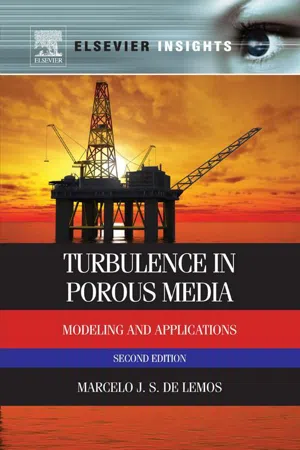
- 408 pages
- English
- ePUB (mobile friendly)
- Available on iOS & Android
eBook - ePub
About this book
Turbulence in Porous Media introduces the reader to the characterisation of turbulent flow, heat and mass transfer in permeable media, including analytical data and a review of available experimental data. Such transport processes occurring a relatively high velocity in permeable media are present in a number of engineering and natural flows. This new edition features a completely updated text including two new chapters exploring Turbulent Combustion and Moving Porous Media. De Lemos has expertly brought together a text that compiles, details, compares and evaluates available methodologies for modelling and simulating flow, providing an essential tour for engineering students working within the field as well as those working in chemistry, physics, applied mathematics, and geological and environmental sciences.
- Brings together groundbreaking and complex research on turbulence in porous media
- Extends the original model to situations including reactive systems
- Now discusses movement of the porous matrix
Frequently asked questions
Yes, you can cancel anytime from the Subscription tab in your account settings on the Perlego website. Your subscription will stay active until the end of your current billing period. Learn how to cancel your subscription.
No, books cannot be downloaded as external files, such as PDFs, for use outside of Perlego. However, you can download books within the Perlego app for offline reading on mobile or tablet. Learn more here.
Perlego offers two plans: Essential and Complete
- Essential is ideal for learners and professionals who enjoy exploring a wide range of subjects. Access the Essential Library with 800,000+ trusted titles and best-sellers across business, personal growth, and the humanities. Includes unlimited reading time and Standard Read Aloud voice.
- Complete: Perfect for advanced learners and researchers needing full, unrestricted access. Unlock 1.4M+ books across hundreds of subjects, including academic and specialized titles. The Complete Plan also includes advanced features like Premium Read Aloud and Research Assistant.
We are an online textbook subscription service, where you can get access to an entire online library for less than the price of a single book per month. With over 1 million books across 1000+ topics, we’ve got you covered! Learn more here.
Look out for the read-aloud symbol on your next book to see if you can listen to it. The read-aloud tool reads text aloud for you, highlighting the text as it is being read. You can pause it, speed it up and slow it down. Learn more here.
Yes! You can use the Perlego app on both iOS or Android devices to read anytime, anywhere — even offline. Perfect for commutes or when you’re on the go.
Please note we cannot support devices running on iOS 13 and Android 7 or earlier. Learn more about using the app.
Please note we cannot support devices running on iOS 13 and Android 7 or earlier. Learn more about using the app.
Yes, you can access Turbulence in Porous Media by Marcelo J.S. de Lemos in PDF and/or ePUB format, as well as other popular books in Physical Sciences & Aerodynamics. We have over one million books available in our catalogue for you to explore.
Information
PART ONE
Modeling
1 Introduction
2 Governing Equations
3 The Double-Decomposition Concept
4 Turbulent Momentum Transport
5 Turbulent Heat Transport
6 Turbulent Mass Transport
7 Turbulent Double Diffusion
8 Turbulent Combustion
9 Moving Porous Media
1
Introduction
Only two things are infinite, the universe and human stupidity, and I’m not sure about the former.
Albert Einstein
1.1 Overview of Porous Media Modeling
Due to its ever-broader range of applications in science and industry, the study of flow through porous media has gained extensive attention lately. Engineering systems based on fluidized bed combustion, enhanced oil reservoir recovery, underground spreading of chemical waste, enhanced natural gas combustion in an inert porous matrix, and chemical catalytic reactors are just a few examples of applications of this interdisciplinary field. In a broader sense, the study of porous media embraces fluid and thermal sciences and materials, and chemical, geothermal, petroleum, and combustion engineering.
Accordingly, applications that are more complex usually require appropriate and, in most cases, more sophisticated mathematical and numerical modeling. Obtaining the final numerical results, however, may require the solution of a set of coupled partial differential equations involving many coupled variables in a complex geometry. This book shall review important aspects of numerical methods, including the treatment of multidimensional flow equations, discretization schemes for accurate solutions, algorithms for pointwise and block-implicit solutions, algorithms for high-performance computing, and turbulence modeling. These subjects shall be grouped into major sections covering numerical formulation and algorithms, geometry, and turbulence.
1.1.1 General Remarks
During the past few decades, a number of textbooks have been written on the subject of porous media. Among them are the works referred to in Muskat (1946), Carman (1956), Houpeurt (1957), Collins (1961), DeWiest (1969), Scheidegger (1974), Dullien (1979), Bear and Bachmat (1990), and Kaviany (1991). Advanced models documented in recent literature try to simulate additional effects such as variable porosity, anisotropy of medium permeability, unconventional boundary conditions, flow dimension, geometry complexity, nonlinear effects, and turbulence. Not all these flow complexities can be analyzed with the early unidimensional Darcy flow model. Recognizing the importance of these applications, the literature has been ingenious in proposing a number of extended theoretical approaches. Below is a short review of basic equations governing fluid flow, followed by a summary of some of the classical models for analyzing transport phenomena in porous media.
1.1.2 Fundamental Conservation Equations
The basic conservation equations describing the flow of a fluid through an infinitesimal volume can be written in a compact form as
...Table of contents
- Cover image
- Title page
- Table of Contents
- Copyright
- Dedication
- Preface to the First Edition
- Preface to the Second Edition
- Overview
- List of Figures
- List of Tables
- Nomenclature
- PART ONE. Modeling
- PART TWO. Application
- References